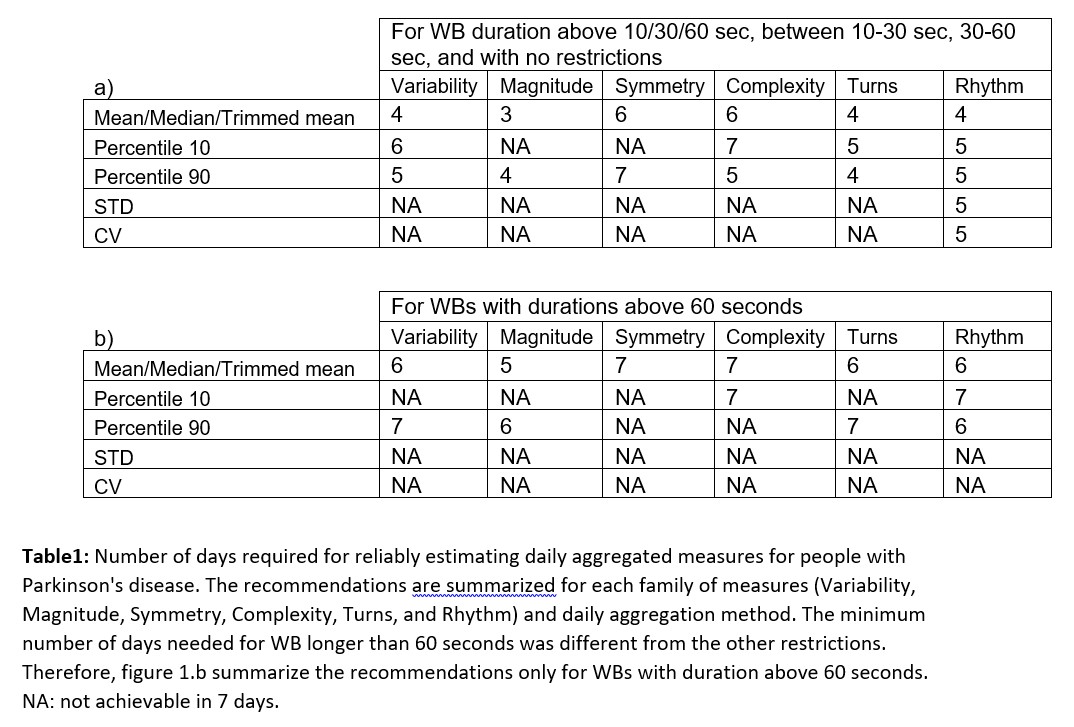Category: Technology
Objective: To determine the number of days needed to obtain reliable, diverse digital mobility outcomes (DMOs) from daily activity recordings obtained using a lower back, inertial measurement unit (IMU) as a function restriction and aggregation choices.
Background: IMU recordings of daily activity have the potential to provide insights into disease progression and treatment. DMOs, calculated from walking bouts (WBs), serve this purpose. However, it is not clear which WBs should be used (e.g. short or long ones) or how to reliably aggregate the multiple measures.
Method: 558 people with Parkinson’s disease (PD) who participated in the Mobilise-D project wore an IMU on their lower back for up to 7 days; a total of 3767 days were analyzed. 78 DMOs were calculated across 6 domains: within-bout variability (e.g. stride length CV), magnitude (e.g. range of the signal), rhythm (e.g. dominant frequency), symmetry (e.g. step regularity), turns (e.g. peak angular velocity) and complexity (e.g. sample entropy). These measures were calculated for each day using 6 different WB duration restrictions (WB duration above 10/30/60 sec, between 10-30 sec, 30-60 sec, or no restrictions) and 7 daily aggregation methods (mean, trimmed mean, median, percentile 10/90, STD, and CV) during waking hours (7am-10pm). The minimum required number of measurement days was determined for each DMO as the lowest number of days that achieved an ICC>0.8 and lower bound>0.5.
Results: See Table1
Conclusion: The number of days needed to achieve a reliable DMO ranges from 3 to 7 and depends on the DMO and the aggregation method. When WBs longer than 60 sec are especially relevant, the specific recommendations differ. The decision of how many days of daily activity to use can be approached in two different ways. When addressing a specific clinical question, it is possible to decide a priori which measures and aggregation methods to pick and use Table1 to find the minimally needed number of days. However, when there is no a priori knowledge on which DMOs to use, we recommend to use the highest number of days based on the wear time compliance of the participants. In this strategy, more days will allow using more DMOs in the analysis, but some participants may be excluded because of insufficient wear time.
Table1
To cite this abstract in AMA style:
E. Gazit, J. Garcia-Aymerich, J. Buekers, S. Del Din, A. Mueller, W. Maetzler, A. Yarnall, C. Schlenstedt, A. Nieuwboer, A. Mirelman, H. Gassner, D. Singleton, B. Vereijken, L. Rochester, JM. Hausdorff. How many days are required to reliably estimate diverse digital mobility outcomes from various gait domains with a lower back sensor in people with Parkinson’s disease? [abstract]. Mov Disord. 2024; 39 (suppl 1). https://www.mdsabstracts.org/abstract/how-many-days-are-required-to-reliably-estimate-diverse-digital-mobility-outcomes-from-various-gait-domains-with-a-lower-back-sensor-in-people-with-parkinsons-disease/. Accessed May 11, 2025.« Back to 2024 International Congress
MDS Abstracts - https://www.mdsabstracts.org/abstract/how-many-days-are-required-to-reliably-estimate-diverse-digital-mobility-outcomes-from-various-gait-domains-with-a-lower-back-sensor-in-people-with-parkinsons-disease/

